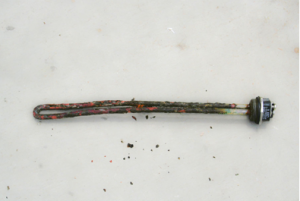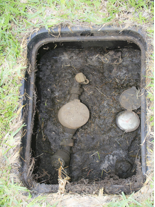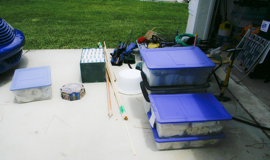 Today’s guest writer is Jonah Gibson of Days of Living Aimlessly. He is retired, living life now as an artist and home repairman, as you will read below. He is someone I am connected with in various ways (S30P, Facebook, our blogs), always appreciating our interactions. Once you read his piece here, head over to his blog, follow him on Twitter, and Studio30 Plus too.
Today’s guest writer is Jonah Gibson of Days of Living Aimlessly. He is retired, living life now as an artist and home repairman, as you will read below. He is someone I am connected with in various ways (S30P, Facebook, our blogs), always appreciating our interactions. Once you read his piece here, head over to his blog, follow him on Twitter, and Studio30 Plus too.
~~~~~~~~~~
Since I lost my job as an accountant (I’m considering retroactive retirement now that it’s been legitimized by Mitt Romney.) my progress toward some new form of usefulness is frequently stymied by a more domestic requirement to do something useful. You see, there is the usefulness to which I aspire, and then there is the usefulness to which I am indentured by the relentless deterioration of my life as I knew it.
The usefulness to which I aspire is the usefulness of the artist—writer, photographer, sculptor, tinkerer, and maker of the kinds of interesting things that people can’t resist reading, looking at, or touching. I measure this usefulness by the amount of money I make from the effort. $90.35 over the last two years. As you can imagine, I am not giving myself high marks for utility so far, but I remain optimistic.
My latest project is this 46×30 inch framed canvas print. I took the pictures, combined and manipulated the images, farmed out the actual printing, stretched the resulting canvas, and built the frame myself. I took a long time to do it. I put everything else aside to get it done. I haven’t written a word or posted a blog for nearly a month. Even worse, I’ve let my personal hygiene slide into a state of appalling decrepitude.
It took way longer than I imagined it would before I started. In my defense, much of what I did was a first effort, and I was learning by trial and error what works and what doesn’t. The next one should go a lot quicker. It had better.
I am almost pleased with the results. I say ‘almost’ because I know where all the flaws are in my work, and their niggling presence is driving me to distraction. Still I think it looks pretty good. I’ll be ecstatic if it sells for the price I’ve put on it of $475. I’m not holding my breath.
Everything I do lately seems to take longer than I’d like it to. At least with my art projects I have the excuse that I’m reinventing myself and trying to settle into new techniques and processes that, hopefully at least, will differentiate me from all the other unemployed (oh, yeah, retired) schmucks who are also trying to earn some money from art. I’m still climbing the steep part of the learning curve.
More irksome is the length of time it takes me to accomplish the mundane tasks of my day-to-day life—especially the little maintenance jobs that take me away from my primary goal of becoming what I want to be when I grow up. Saturday was an excellent case in point. Saturday I had to fix our water heater.
Early last week our hot water supply started getting erratic. By Friday we were getting ‘failed’ messages on our dishwasher and there wasn’t enough hot water for one shower let alone the three we need through the summer when there is almost always a grandchild here making our lives worth living while at the same time taxing our meager resources.
I figured I needed to replace the heating element. Our water heater has two—an upper and a lower. I read a description of the way two elements are supposed to work on line. The gist of it was the upper heats the top of the tank, and then switches on the lower. What this means is that if you are getting any hot water at all, the top element is working. If the top element isn’t working it won’t shunt any work load to the bottom unit because the top of the tank won’t ever get hot. This meant that my problem was the lower unit.
Unfortunately this turned out to be the only thing about this little job that went as expected. It was indeed the lower heating element that was bad. Here’s the photographic evidence:
Everything else about this job was an exercise in frustration.
There are really only two steps to replacing a heating element in an electric water heater. You unscrew the old one, and screw in the new one. Of course there are steps leading up to and trailing off from these essential two, but they are all common sense preparation for and buttoning up after the necessary steps. The complete list of steps looks like this:
- Turn off the electric power to the water heater.
- Turn off the water supply to the water heater.
- Attach a hose to the spigot at the bottom of the water heater.
- Drain the tank.
- Unscrew the old heating element.
- Screw in the replacement heating element.
- Close the spigot at the bottom of the water heater.
- Turn on the water supply to the water heater.
- Check for leaks. Tighten and/or seal the heating element if necessary.
- Turn the electric power to the water heater back on.
I left out one important step. I left it out because so did virtually every other description of the process that I read or watched a video of on this wonderful thing we call the Internet. As we all know, the Internet is a place where you can learn how to do anything you can think of…but not necessarily correctly. Fact checking is optional on the Internet. In fact, fact checking, apparently, is for sissies.
It is the arbitrary and optional nature of facts in this environment that makes the Internet such a satisfying venue in which to indulge one’s taste for politics. The unfortunate fallout, however, is that information on things like wiring your house and making explosives are subject to the same level of accuracy.
I’ll get to the important, left-out step in just a minute.
Step one went exceedingly well. I turned the electricity to the water heater off at the junction box and was subsequently not electrocuted. Freaking yay!
Step two was a different matter. You would think that turning off the water supply to the water heater would be a simple matter—nearly as simple as flipping a switch on a junction box. There is a faucet handle right on top of the water heater tank to accomplish this. What could be simpler? ‘Righty tighty’ and you’re finished. In my case, not so much.
I ‘rightied’ a lot. I ‘rightied’ until the cows came home, but I never got any ‘tighty’. The valve wasn’t frozen because it spun freely. It’s just that the spinning didn’t do anything…least of all close the valve.
I tried a lot of stuff at this point. I sprayed the valve with WD-40. I tapped it with a hammer. I uttered a sincere prayer, and I cursed it roundly. Nothing made the water shut off.
Let me rephrase that. Nothing happened to indicate that the water had indeed shut off.
I decided to start draining the tank anyway. Step three. What I thought was, maybe I had shut off the water and just didn’t know it. Or maybe I’d slowed the water intake enough that the tank would drain anyway, even if water was still trickling in. Or maybe a better idea would occur to me while I was making progress toward unscrewing the bad heating element. Like I said, I’m an optimist…sometimes anyway.
I attached the hose to the bottom spigot, ran the hose out the garage door, and opened the spigot. Water started flowing into the yard. So far so good.
I went into the house to think some more about how to shut off the water supply. It was cool inside the house. My wife was there for moral support. She wanted me to call my brothers-in-law to get some help. My wife likes to make a community project out of almost everything. I like to do everything by myself. I figure the fewer people involved, the fewer people involved who have no clue what they are doing. Nothing succeeds quite so well when you are frustrated and confused as the attraction of bad advice. Taking bad advice sucks a lot worse than just being stupid.
Anyway the cool of the house and the pressure by my wife to involve my brothers-in-law motivated me to come up with an excellent Plan B. I would shut off the water at the main. Brilliant.
I went looking for the main shut-off valve. My wife said it was on the side of the house under the garden hose spigot. I looked there. There was indeed a valve there, but it didn’t look like a main shut-off to me. It looked like a lead to an automatic lawn sprinkler system—something we do not have. I turned the valve to see what might happen. Just like the inlet valve on top of the water heater, the thing spun freely, but there was no rewarding sensation of a valve actually closing. On to Plan B(b).
By this time my wife had e-mailed everyone in the family to let them know my lack of progress thus far. Advice had begun to pour in. Freaking yay!
Plan B(c) involved calling my nearest brother-in-law to ask him if he knew where the main shutoff was. He said he’d be over as soon as he got a haircut.
By the time he arrived the water flow from the hose had slowed to a trickle, and I had convinced myself that the tank was mostly drained and that the trickle represented the water coming in through the intake. I figured that it would probably be safe to remove the lower heating element at that point because the water level in the tank was surely below the opening for the element.
Even though this made perfect sense to me at the time, I decided to wait on my brother-in-law anyway…just to be sure. Good thing too, because he quickly identified the main shut-off right next to the water meter, and we turned off the water supply to the house. Immediately the trickle from the hose stopped, confirming my notions about the amount of water remaining in the tank.
We set about unscrewing the lower heating element. It wouldn’t budge. If you’ve been reading along with any care at all, you already guessed that much. Our problem was that we didn’t have the proper tool to get the thing out. We needed a wrench made specifically for electric water heater elements.
We also needed a new element so we set out for the local building supply superstore to buy tools and parts. In my experience this was going to be the first of several trips to get the job done. Sometimes I an not an optimist, but I do love a trip to the hardware store.
We returned to the house about 45 minutes later with a heating element, an element wrench, and full of greasy jumbo hot dogs we had bought from a vendor cart in front of the store.
The hot dog was lying heavy in my stomach, but I felt good about our prospects for the rest of the job. I put the wrench on the old heating element and gave it a turn.
I carry a cell phone, but sometimes I wonder why. I only get one or two calls a month. They always seem to come in at the worst possible time. This one, from my wife who was out shopping with her sister, was no exception. It came smack in the middle of the raging flash flood in my garage.
I was not ready to field a phone call. I was very busy imagining what Pharaoh’s generals must have felt like, standing in their chariots on the dry floor of the Red Sea and watching Moses wave his staff atop an outcropped rock on the far shore. This is not a circumstance in which it is possible to be polite, or even civil, to someone who has just called you up on the phone to discuss some random pleasantry. If this kind of crap never happens to you, then you’ll just have to trust me on this point. Whatever comes out of your mouth in a situation like this is completely excusable.
My wife wanted to know if they should bring us lunch. I was thinking that if I had brought that jumbo hot dog home instead of eating it in the parking lot, I could now shove it into the hole where the heating element had been and staunch the flood that was threatening to float a lot of my stuff out into the driveway. I thought about stuffing the cell phone in there, but I was running short on energy for creative solutions. I told my wife that I couldn’t talk because I was having a crisis, and hung up. Chances are pretty good that those were not my exact words.
At this point is is probably worth noting that my cursing had escalated somewhat from the level usually identified with drunken sailors to the level now practiced by the average mommy blogger. (Along with the aforementioned paucity of fact checking, anonymity is another Internet hallmark fraught with surprising consequences.)
The brother-in-law and I started a bucket brigade of sorts. I held one bucket under the stream of water coming out of the still pretty full tank while my brother-in-law emptied a second. He carried 10 two gallon buckets out into the yard. There was almost that much water on the floor. It was a mess, and I was reminded, once again, why I do not keep firearms in my house. I would have shot that water heater dead…and probably some other stuff as well.
It took the better part of an hour to get all the junk that might trap water out of the garage, sweep out the standing water, and rig three fans to dry out what was left.
Now all this mess was the direct result of the step I left out of the maintenance process I enumerated above—the step everyone else left out as well. There is a vacuum relief valve on top of the water heater. When you drain the tank, you need to open this valve or the vacuum in the tank will prevent the water from draining completely. In plumbing, like nearly everything else, the devil is in the details.
When we’d cleaned the water up, I went back to work replacing the heating element. The new element went in with no problem. I reconnected the wiring, shut off the drain spigot, turned the water main back on, and waited for the leaking to begin. Leaking did not begin (freaking yay one last time!) although it would have been hard to tell what with so much water still on the floor. I was feeling almost gratified at this point—a job, if not particularly well done, at least done, which was certainly better than anything in Plan C.
It was 3:00 pm by the time I got everything back together and put away. I was tired, hot, dehydrated and out-of-sorts. I went back into the house and took my blood pressure meds with a martini. A routine maintenance job that should have taken twenty minutes had stretched out to six hours. I’ll never get that time back. Neither will you now because, if you’ve got this far, you’ve just wasted a good quarter hour reading all about it. Misery loves company, and an artist looking for utility loves a cautionary tale.




Comments
2 responses to “Home Maintenance and the Thorny Path to Usefulness”
I had to stop reading many times to wipe my eyes – I’m still waiting to stop laughing! Jonah, you are a HOOT!!!
Hey Jonah you just touched my heart!